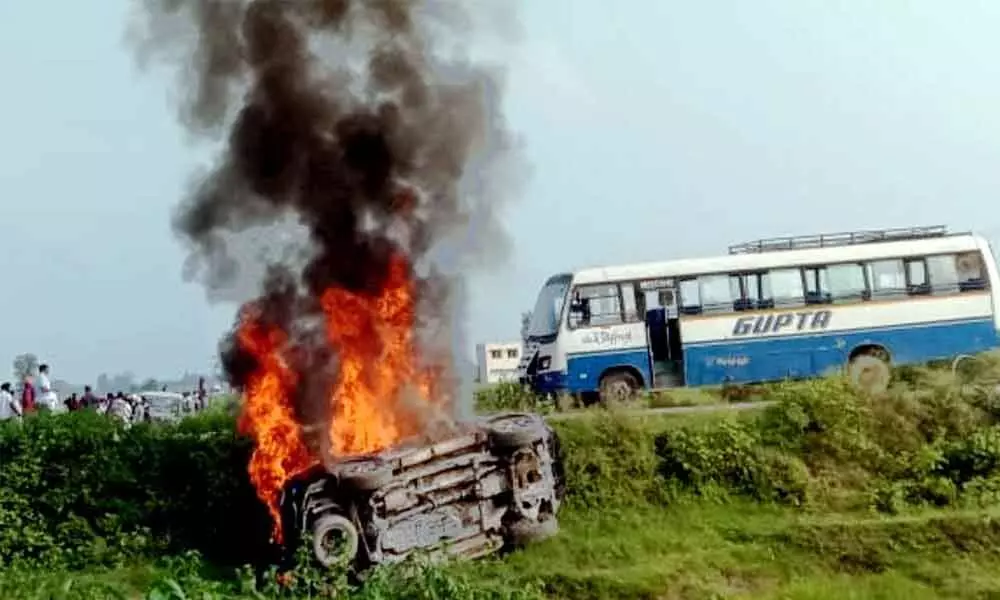Live
- Hyderabad Biryani's reputation is at risk: Cigarette Butts, Bugs, and More
- Jabardasth Varsha Launches Vivo Y300 5G Mobile in Hyderabad
- Rains continue in Tamil Nadu, standing crops hit in Cauvery delta areas
- EAM Jaishankar meets Italy's counterpart during G7 Foreign Ministers' Meeting
- Parliamentary Committee on Waqf bill to meet today
- Delhi-NCR air quality deteriorates as AQI nears 'severe' levels
- Telangana Government Issues Clarity Over Zilla Parishads Confusion
- AP Dy. CM Pawan Kalyan Condemns Arrest of ISKCON Preacher in Bangladesh
- In LS today, FM Nirmala Sitharaman to move Bills to amend banking laws
- Gold rates in Hyderabad today surges, check the rates on 27 November, 2024
Just In

Lakhimpur Kheri violence
The Lakhimpur Kheri violence stands out for its brutality in every sense. Here was a stream of farmers moving back to their destinations after staging a protest against the BJP leaders, including a Union Minister of State, who were arriving there to take part in some programme.
The Lakhimpur Kheri violence stands out for its brutality in every sense. Here was a stream of farmers moving back to their destinations after staging a protest against the BJP leaders, including a Union Minister of State, who were arriving there to take part in some programme. Farmers have been protesting against the political leaders, more so against the BJP leadership, in UP, Haryana and Punjab for the past few days in a bid to mount pressure on the Centre to concede their demands for repeal of the three farm laws which they feel are detrimental to their interests.
The stalemate has been continuing over the issue for nearly a year now. Violence was expected to arise at some point of the time or the other. However, the fact that four farmers had to die coming under the wheels of cars of a convoy, deliberately or otherwise, is most unfortunate. As usual, there are two versions to it with the farmers claiming that the victims were mowed down by the BJP men, while the latter claimed that their vehicles were attacked and a car overturned falling on the victims leading to their death. That is for investigation. What is even worse is that four BJP workers were bludgeoned to death by the angry farmers. Both the incidents speak volumes about the civility that prevails in this belt. It was no Galwan and no one was defending any country. Yet the two sides decided to take law into their own hands.
The farmers' protest was only democratic, and they had every right to do so. Of course, they did not have any right to take away anyone's life in retaliation to the accident. Politics need not descend to these levels. The refusal of either the farmers or that of the ruling BJP to thrash out the issue amicably is bewildering. Should there be such a prolonged agitation over some laws in the country? Why cannot both the parties sit down to talk and arrive at a solution? The other day the Apex Court too expressed its anger at the prolonged agitation that was inconveniencing the citizens of the National Capital Region.
Non-violence doesn't just mean not doing violence; it's also a way of taking positive action to resist oppression or bring about change. The aim of non-violent conflict is to convert your opponent; to win over their mind and heart and persuade them that your point of view is right. An important element is often to make sure that the opponent is given a face-saving way of changing their mind. Non-violent protest seeks a 'win-win' solution whenever possible. In non-violent conflict the participant does not want to make their opponent suffer; instead they show that they are willing to suffer themselves in order to bring about change. Those who swear by Gandhi while sitting in protests and those who pay floral tributes to the Father of the Nation at Raj Ghat should equally remember that the essence of non-violent technique is that it seeks to liquidate antagonisms but not the antagonists. No more Lakhimpur Kheris please! Both sides should bury their egos and evolve a solution.

© 2024 Hyderabad Media House Limited/The Hans India. All rights reserved. Powered by hocalwire.com







